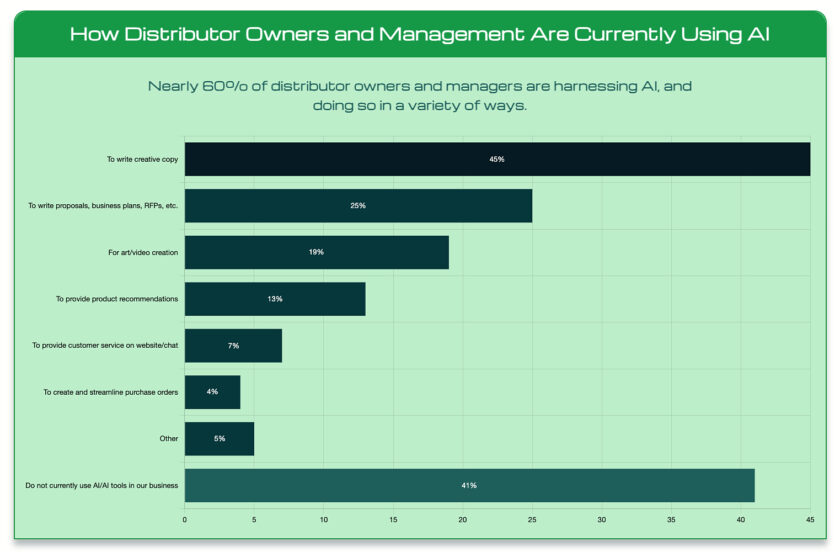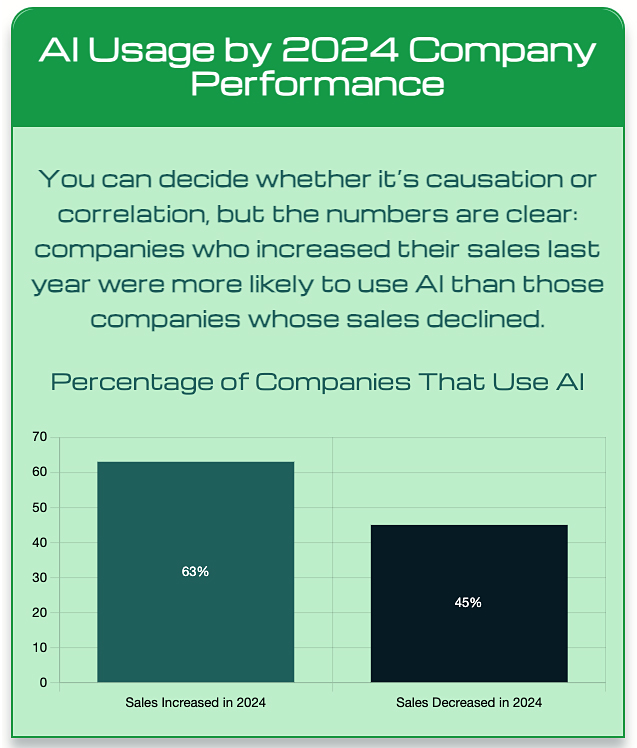No one really has the answers; everything is an educated guess at this point – it’s all just so new. Even the experts who are pouring their lives into figuring things out qualify statements as conjecture and estimates.
And, unfortunately, asking the likes of ChatGPT won’t help you.
We’re only a couple years into this whole AI experiment – at least from the perspective of it entering the mainstream and being positioned as the biggest technological advance since the internet. For distributors, suppliers and millions of other businesses, AI is very much still a new thing.

“Basically we’re recognizing that this is year three of AI if you will,” says Rebecca Klapper, director of marketing and brand for Counselor Top 40 distributor Boundless (asi/143717), which is using AI in a number of ways – primarily in “finicky, data-heavy tasks” like parsing company data and gleaning some takeaways from intimidating spreadsheets. “I would say we’re growing with it as much as we can.”
If AI still feels intimidating or foreign, rest assured you’re not alone. Within the last year, ASI Research found that 41% of distributors are not using AI or AI tools in their business. Of those distributors who do use AI in the promo industry, 45% use it to write creative copy, 25% to write things like proposals and RFPs, 19% for video creation, and 13% to provide product recommendations.
And perhaps most interestingly, size has little bearing on adoption rates – for example, 62% of small distributors ($250K or less in annual revenue) are using AI compared to 61% of extra large distributors (more than $5 million).

What’s the Defining Trend of the Next Five Years?
“Without a doubt, artificial Intelligence will advance this industry further than any other trend since the advent of the e-commerce store.”
Jake Himelstein, BAMKO (asi/131431)
The march to automation through digital technology has been going on for decades now. And while the robot uprising may not take place before 2030, it’s clear that generative AI is the form of automation that will have the greatest impact in the next five years – revolutionary, perhaps.
An Artificial Agent
Isar Meitis has made plenty of “bets” on AI, having been in the driver’s seat for multiple businesses in the AI space, including his current AI-focused business named Multiplai. But, he’s not so naïve to pretend he knows what will happen in five years. One year, maybe two? That’s more reasonable. And of the AI developments that he believes will be the most “dramatic,” agential AI might be number one.
“The concept of agents is either fully autonomous or semi-autonomous systems that can understand a goal that we’re trying to achieve across multiple aspects of our business and create the different steps to reach that goal, and assign these smaller tasks to other agents to perform them,” he says. “And all of them have access to all of our data and all of them have access to tools that we would use.”
Think CRM, ERP, email, social media – the necessary things beyond simply buying and selling. These “agents” would handle it the same way a human or team would.
“2025 is the year where this is going to explode, and then obviously it’s going to continue into 2026 and 2027,” says Meitis, who spoke at the 2024 ASI Power Summit. “But agents are something that all the big providers are working on, and it’s going to be completely life-changing to everything that we know, because they will be able to do complete jobs and not just small segments of tasks as they’re doing today.”
In late January, ChatGPT previewed its “Operator” agent service, which can interact through web browser and other interfaces to perform tasks including “filling out forms, ordering groceries, and even creating memes.” Google in December announced its own agentic AI model, Gemini 2.0.
And bigger changes could await. While generative AI’s greatest impact is in the digital realm, there are already AI-driven robots (though not humanoid in appearance) being used by very large suppliers to speed up fulfillment and increase efficiency and safety. Meitis notes that current warehouses may have a lot of efficiency, but “there’s always still that final 20% that humans do. This may not be necessary three years from now. Companies that manufacture these robots are planning on manufacturing tens of thousands or hundreds of thousands of them in 2026.”
Generating & Analyzing
David Radin, CEO of Confirmed LLC, knows a thing or two about how AI can help with time management. It’s the subject of his series of workshops, “Time Management in the Age of AI.” It stands to reason that he’d be in favor of how generative AI and agential AI can save time, but he’s careful not to paint with broad strokes or oversell.

“There are a lot of people out there who are using tools to create sales text,” he says. “Even though it might sound really good most of the time, the person on the other end knows that it’s been generated by AI. You need to go through and say, ‘What do I want this to say? Does it say it the way I want?’”
AI can produce a lot of creative materials that would be helpful to distributors and suppliers: product copy, presentations, email marketing, blog posts, images, graphic design – the list goes on and on. But, like with any writer or designer, AI-generated assets still needs proofreaders and quality checks, particularly because it’s prone to what’s called “hallucinating.” Because AI platforms pull data from existing content and create the closest approximation using the data it’s fed, it can create content that appears correct but isn’t actually so. It might cite information from a university that sounds real but isn’t. It might deliver data that sure includes a lot of numbers and factual-looking statements, but aren’t true. Imagine it being a very confident speaker who is sometimes prone to lying, afraid to say “Huh, I don’t know the answer to that question.”

What’s the Defining Trend of the Next Five Years?
“If we can become well versed and thought leaders in technology and automation, I think there’s going to be more opportunities for clients to lean in and trust us. When your customers start trusting you with their data, you know you’re on the right path.”
Brian Gill, Thumbprint (asi/305623)
The hope and belief is that this will become less of an issue soon. “It’s already significantly better than it was even just a year ago,” Meitis says. “All the major labs are working on fixing and handling this issue through various methods. I believe within the next 18 months, hallucinations will still be there, but would be negligible.”
Still, different problems could arise due to the very nature of the AI model itself. “In situations for which AI is not previously trained to encounter your request, it uses generalities from multiple sources or make things up,” says Radin. “Keep in mind that GenAI doesn’t think it can be wrong – even in cases when it subsequently corrects itself. If you ask it whether it can do something, expect it to say yes, even when it can’t do it. So, even that answer is wrong. That last bias is particularly difficult to fight.” Radin also warns that as these platforms draw from the internet content that exists, you run the risk of using copyrighted material.
Many AI companies have been working toward AGI – artificial general intelligence, a point where AI matches or even surpasses human intellect across the broad spectrum of tasks that humans can perform. The concept is theoretical though and, if possible, is expected to require anywhere from 15-25 years to achieve.
Right now though, current models of AI can help distributors and suppliers immediately. Radin mentions analyzing customer data and other grunt-work tasks that take up a lot of the clock, especially when you’re frequently traveling and time is precious.
Boundless’ online guide for harnessing the power of AI includes capabilities like web design and marketing tasks such as A/B testing, ad optimization, generating written content and graphic design; there’s also customer service functions such as more human-like chatbots. “We’re definitely trying to become more data-driven,” Klapper says. “So using AI from a data perspective, seeing if there are any ways to quickly figure out where trends are and predict future moves, I think that’s really exciting.”
AI Features in ESP+
ESP+ offers numerous AI-powered features to streamline content creation and optimize search results for specific clients. They include:
- AI in ESP+ Presentations will write a draft of a proposal for a client and take into account contextual details about the customer’s needs.
- AI in ESP+ Search will suggest relevant products from ASI’s vast database of suppliers for a specific end-buyer – think a church group’s golf outing, or a health benefits update launch party for a veterinary practice.
- AI in ESP+ Websites helps distributors generate site descriptions and keywords. This helps to quickly create recommendations that can optimize search engine optimization (SEO).



